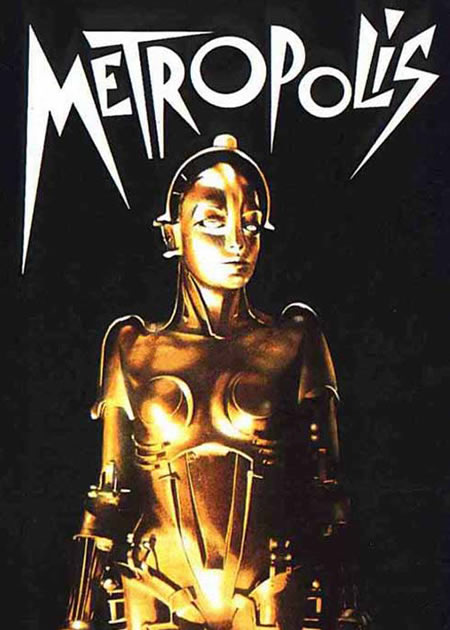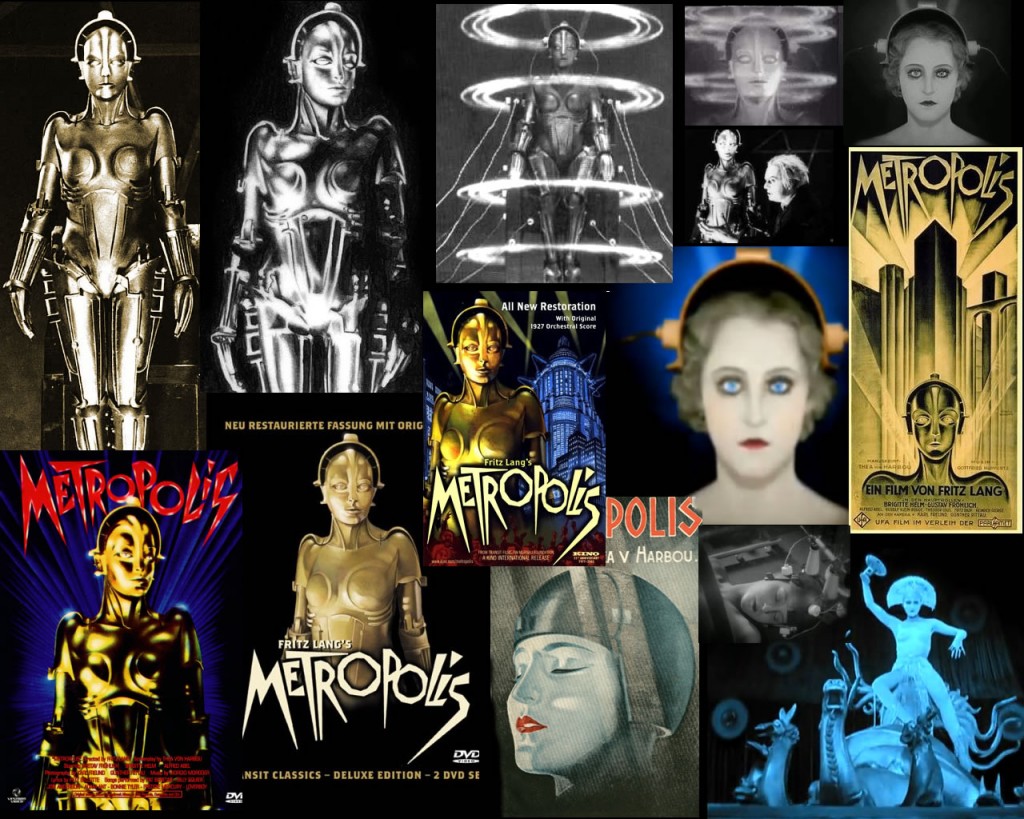Posts Tagged ‘Metropolis’
 Metropolis Science-Fiction and Lifelike Robot – Was it Ahead of its Time?
Metropolis Science-Fiction and Lifelike Robot – Was it Ahead of its Time?
The book Metropolis is dated back to 1925 and the film (see below pictures of Maria transformed into a shiny then lifelike female robot), the most expensive silent movie ever made, was made two years later. A droning yet very powerful storyline, it is difficult to believe it dates back to the 1920s. Yes, the quality of the film, the old 35 mm tape and a later duplicate copy of 16mm, support its true age but the plot is not dissimilar to our lifestyles of today.
Reminiscent of Today?
It describes a life on two levels – thinkers (the managers) and doers, the workers who, like in many of today’s big businesses, exist as numbers or statistics, rather than as real human beings. The two level separation is carried one stage further, in that the workers work underground, eyes glazed with such monotonous work, while the masters work above ground, in what features as a brightly-lit city, heavy with traffic and taxis and sporting not only the Eternal Gardens but alsoYoshiwara, its own red light district, for the pleasures to be found within.
The Storyline.
Fredersen is the powerful master of the city of Metropolis, devoid of feelings and he is the almighty one who controls life underground. He lives in his own purgatory, brought on by the death of Hel, the woman he loved, who originally belonged to another (Rotwang). Whilst Rotwang is responsible for making man machines to work in the underground city, his loss of Hel causes him to create a female robot in her image. That is, all except for the face, for this intelligent female robot, which can read minds and can destroy men, remains faceless for a significant part of the story.
The real problems start when Freder, the son of the master of Metropolis, finds out about this underground life of Hell and sets off on a course to right the wrongs of his father. Whilst basking in the pleasures of the Eternal Gardens, where geisha-like girls attend to his every whim, he sees a young girl enter, followed by many ghostlike children. Struck with instant love for her, Freder goes on a mission of not only finding the girl, Maria, but also discovering the underground world that drones on and on, without sleep or remission.
The vocabulary of the book keeps you in the moment. Machines are described in vivid detail e.g. ‘the machine which was like Ganesha, the god with the elephant’s head’ and the same machines are described again and again. Yet, although you are kept in the moment, it is difficult to keep track of what is going on, as some vocabulary is very much elaborated.
‘Black in the background, the cathedral, ungodded, unlit, the place before the broad steps swarming with human beings and amid them, surrounded by gasps of madly despairing laughter, the howling of songs of fury, the smouldering of torches and brands, high up on the pyre . . ‘.
Such detail will come across very effectively in film form, much easier than trying to keep track of such busy animation in the crowded vocabulary of a book.
As the story continues, it comes to light that the female robot has been given the face of Maria. So now there is one evil and one genuine Maria and the story takes on the role of an action-packed thriller, with fighting in the underground world, the cathedral and in the streets.
Experts in Their Time.
When watching the original film, one can’t help but wonder how the filmmakers of that time created such special effects. Even now, in the twenty-first century, aren’t we still in awe of what special effects can achieve?
The story ending of Metropolis has a most unusual twist, one that could not have been imagined and, like the very best of love stories, it will bring tears to your eyes. Why spoil it, by saying any more?
Written by Denise Watson
 Metropolis and the Sexy Female Robot – Is the Book Better Than the Film?
Metropolis and the Sexy Female Robot – Is the Book Better Than the Film?
Metropolis is best known for the sexy female robot Maria. I read the book before watching the film to draw a comparison between the book and the film. How many times do we hear that the book is better than the film and can this be said of all genres e.g. war, love stories, human-like robots etc.?
In a book, the words give you everything. They create the landscape, the actions and the characters, yet everyone who reads the book will create a different visual picture. With a film, we will all see the same picture, hear the same words and digest more or less the same story.
But what about a silent movie? Without a full dialogue, can a science fiction film like Metropolis really come up with the goods?
A downloaded copy of the book constituted 213 pages. The story line is a world where people have become numbers, there is a clear situation of ‘them and us’ and ‘man machines’ are the order of the day. Robot technology is its key.

Metropolis female robot poster
The repetitive language seems to drag you along, stealing your freedom of thought and this is extremely clever, for you have become a machine, a robot, like the men in the book who are brain dead from such repetitiveness work duties. You will have little idea of what is going on, maybe again by design for, part way through the book, it says ‘the hands worked for wages ….. the hands didn’t even know what they were making’. Unfortunately, this state of mindlessness affects your visual understanding of the erotic dance scene, so Maria doesn’t come across as a sexy female robot.
The film is of the old spool-type quality: think Charlie Chaplin and you’re there. The first ten minutes include a very touching introduction followed by about forty words or so, all trying to carry the story forward. Our understanding is therefore almost entirely in the hands of the actors and actresses, who use non-verbal communication to deliver the story.
Watching the lethargy of the robotic yet human workers as they enter the Paternoster lift to start work, their lack of interest and even heart are evident and the impressive body language and facial gestures of Freder (played by Gustav Frohlich) clearly put across the message that, in that very moment, he is lovestruck.
Maria is certainly a very sexy female robot in the erotic dance and, had the original audiences believed her to be a human being, she would probably have been labelled a hussy. Wearing a most delicate see-through gown, she cavorts with intent and the lust is well-portrayed, in the male actors’ staring eyes. I should imagine she also had the same effect on the male audience of that time. Today, films portray very real sex scenes, yet the ‘scandalous scenes’ that Metropolis had to remove ‘or face arrest’ included people playing footsy under the table and Maria removing her dress, though still well-clad in her underwear.
The special effects are incredible. The lighting, the vehicles and flyovers, the skyscrapers and even the motion of the Paternoster were carefully thought out. As regards to that lift, if you look carefully, you will see the illusion of the lift going down when, in reality, it is the backdrop of the lift that is going up. The scenes of the female robot in its making are superb – is it a woman made up as a robot or the reverse? Such genius must have been the forerunner of the likes of the Terminator and the Matrix, which show that special effects can still leave us in awe.
It seems the look of the sexy female robot has little evolved since 1926… the above video from the classic Metropolis by Fritz Lang, includes the Transformation from Maria into the robot Futura and the erotic dance of the life-like robot by the actress Brigitte Helm.
Summing up the book and the silent movie, the latter has more of a sense of warmth about it: the characters feel real and the emotions come through. However, having read the book before watching the film, I already had a fair idea of the plot, so I am left wondering if I would have had the same feeling, if that had not been the case. Either way, watching a silent movie has something special about it, as it’s amazing what you can pick up from the picture itself, even if it is your own personal interpretation.
written by Joan Archer
Metropolis Official Website:
http://www.kino.com/metropolis/

